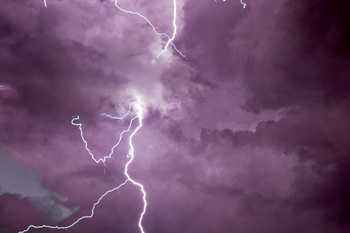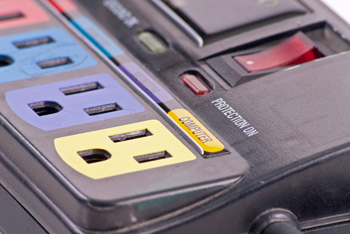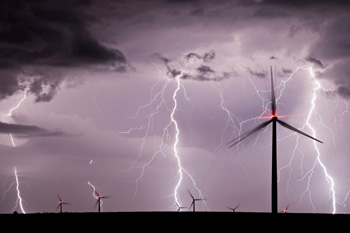Lightning
- Get Prepared
- Nature Safety
- Current: Lightning
Lightning Safety Awareness Week is June 22–28, 2025
Lightning is a deadly force of nature that kills dozens of people and injures hundreds annually in the United States, according to the National Weather Service. There is little a person can do to protect against lightning when outside, so Hoosiers are encouraged to go inside a building or vehicle during thunderstorms. Learn more about lightning and follow additional safety tips below to stay safe.
Lightning Safety Tips
Quick Tips
- Consider buying surge protectors and installing lightning rods or a lightning protection system to protect the home, appliances and electronic devices.
- Know ahead of time where you can seek shelter and how long it will take you to get there if a storm occurs.
- Go inside when thunder or lightning is observed.
- Avoid open areas and stay away from tall, isolated trees or tall objects. When in a forest, seek a lower group of trees. Do not be the tallest object in the area.
- Lightning victims do not carry an electrical charge, so it is safe to touch them. In many cases, a person’s heart or breathing may have stopped, so administer CPR after calling 911 and use an AED if available.

Statistics
- Lightning kills approximately 30 people per year across the United States.
- About 10 percent of people struck by lightning are killed. The remaining 90 percent of people are left with varying degrees of disability, according to the National Weather Service.
- From 2006 to 2024, the number of fishermen killed by lightning (42) was three times more than golfers (14), according to the National Lightning Safety Council. Others: Beachgoers (32), campers (23) and people farming or ranching (24).
- More than 70 percent of lightning deaths occur during June, July and August.

Preparation
Lightning accompanies many storms, so knowing the weather forecast and patterns for the area can be helpful when planning outside activities. Follow these steps to stay informed and protect against lightning damage before a storm arrives:
- Consider buying surge protectors and installing lightning rods or a lightning protection system to protect the home, appliances and electronic devices.
- Monitor the weather before going outside by consulting the local weather forecast and by looking outside for signs of developing or approaching storm clouds.
- Know ahead of time where you can seek shelter and how long it will take you to get there if a storm occurs.
- Do not start an activity outside that you cannot stop quickly if a thunderstorm is expected, especially as early signs of a storm begin.
- Carry a portable weather radio, or have weather alerts set up on a cell phone, to stay alerted of changing weather conditions. Adjust plans to avoid being outside when a thunderstorm is expected.

During a Thunderstorm
Thunder is the shockwave from a lightning strike path. When thunder is heard from a nearby storm, then lightning is within 10 miles and can strike.
- Go inside when thunder or lightning is observed. Seeking cover in large, permanent buildings is best, not picnic shelters or tents.
- When a building is not available, seek shelter in a fully enclosed metal vehicle, such as a car or truck, with the windows completely shut.
- If in a boat, get to shore and indoors as quickly as possible when a thunderstorm approaches.
- If going inside is not possible, such as during a long hike, avoid open areas such as fields or hilltops and stay away from tall, isolated trees or tall objects. When in a forest, seek a lower group of trees. Do not be the tallest object in the area.
- Avoid water, wet items, electronic equipment, landline phones, plumbing and metal objects. They conduct electricity very well, and lightning can travel far along them.
- Avoid windows and exterior doors that may contain metal components.
- Stay sheltered until at least 30 minutes after the last sound of thunder. Electrical charges can linger in clouds after a storm seems to have passed.

When Lightning Strikes
Immediate action is needed to save a victim of a lightning strike, so know beforehand what to do.
- If an individual is struck by lightning, immediate medical attention is needed, so dial 911 right away.
- Lightning can reach temperatures up to 50,000°F, which is hotter than the sun's surface. If it strikes a person, the lightning can cause severe injuries (primarily damage to the nervous system, but also burns). Cardiac arrest can also occur.
- Lightning victims do not carry an electrical charge, so it is safe to touch them. In many cases, a person’s heart or breathing may have stopped, so administer CPR after calling 911 and use an AED if available.
- If possible, move a victim to a safer place inside to avoid another lightning strike.
- Evacuate anyone obviously injured by lightning. A victim could be disoriented or confused, with decision-making dangerously impaired.
Resources
Websites
- Lightning Information for Water Activities
Centers for Disease Control and Prevention - Lightning Safety Tips
National Weather Service - Severe Weather Preparedness
Indiana Department of Homeland Security - Thunderstorms and Lightning
Ready.gov
